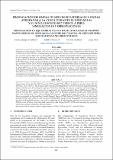Por favor, use este identificador para citar o enlazar este ítem:
https://hdl.handle.net/20.500.12958/4242Registro completo de metadatos
| Campo DC | Valor | Lengua/Idioma |
|---|---|---|
| dc.contributor.author | Quispe-Ccalluari, Carlos | - |
| dc.contributor.author | Chamorro-Gómez, Adolfo | - |
| dc.contributor.author | Arellano, Cinthia | - |
| dc.contributor.author | Tam, Jorge | - |
| dc.date.accessioned | 2022-05-16T16:05:59Z | - |
| dc.date.available | 2022-05-16T16:05:59Z | - |
| dc.date.issued | 2021-12 | - |
| dc.identifier.citation | Quispe-Ccalluari C, Chamorro A, Arellano C, Tam J. 2021. Propagación de ondas de Kelvin ecuatoriales y ondas atrapadas a la costa durante El Niño 2015-16 y El Niño costero 2017 frente a Perú: simulaciones y observaciones. Bol Inst Mar Perú. 36(2): 349-361. | es_ES |
| dc.identifier.issn | 04587766 | - |
| dc.identifier.uri | https://hdl.handle.net/20.500.12958/4242 | - |
| dc.description.abstract | El Ecosistema de Afloramiento Peruano (EAP) es frecuentemente perturbado por el arribo de las Ondas Kelvin de hundimiento en el Pacifico Ecuatorial Oriental, ocasionando efectos en el ecosistema marino y la hidrología frente al Perú. Este trabajo tiene como objetivo comparar las propagaciones de las Ondas Kelvin Ecuatoriales (OKE) durante El Niño 2015-2016 y El Niño Costero 2017 (ENC 2017) frente a Perú, usando modelos de simulación y datos observacionales. Los resultados muestran que durante El Niño 2015-2016, se propagaron siete OKEs de hundimiento (modo 1), de las cuales seis de ellas se propagaron como ondas atrapadas a la costa de hundimiento, mientras que durante la ocurrencia de ENC 2017 frente al Perú, se propagó una OKE de hundimiento (modo 1). Así, mientras que las OKEs de hundimiento jugaron un papel clave en el inicio y desarrollo del calentamiento asociado al evento EN 2015-2016 frente al Perú, para ENC 2017 su rol fue secundario, contribuyendo a extender el calentamiento, ya iniciado por otros procesos. | es_ES |
| dc.description.abstract | ABSTRACT: The frequent arrival of downwelling Kelvin waves in the Eastern Equatorial Pacific altered the Peruvian Upwelling Ecosystem (PUE) thus affecting the marine ecosystem and hydrology off Peru. Therefore, we aim to compare the propagation of the Equatorial Kelvin Waves (EKW) during El Niño 2015/16 and the 2017 coastal El Niño (2017 CEN) off Peru through simulation models and observational data. Our results show that 7 downwelling EKWs (mode 1) propagated along the equator, and then 6 of them propagated as downwelling Coastal-Trapped Waves (CTW) during EN 2015/16. On the other hand, during the 2017 CEN off Peru, only one downwelling EKW (mode 1) was propagated. We can conclude that the downwelling EKWs played a key role in triggering and developing the warming associated with the EN 2015/16 event off Peru, while they had a secondary role during the 2017 CEN, just extending the warming, which was already initiated by other processes. | - |
| dc.language.iso | spa | es_ES |
| dc.publisher | Instituto del Mar del Perú | es_ES |
| dc.relation.ispartofseries | Boletín IMARPE 36(2), 2021; | - |
| dc.rights | info:eu-repo/semantics/openAccess | es_ES |
| dc.rights.uri | https://creativecommons.org/licenses/by/4.0/ | es_ES |
| dc.source | Instituto del Mar del Perú - IMARPE | es_ES |
| dc.source.uri | Repositorio Digital IMARPE | es_ES |
| dc.subject | Ondas de Kelvin | es_ES |
| dc.subject | Ondas atrapadas | es_ES |
| dc.subject | El Niño Costero | es_ES |
| dc.title | Propagación de ondas de Kelvin ecuatoriales y ondas atrapadas a la costa durante El Niño 2015-16 y El Niño costero 2017 frente a Perú: simulaciones y observaciones | es_ES |
| dc.title.alternative | Propagation of equatorial Kelvin waves and coastal trapped waves during El Niño 2015-16 and the 2017 coastal El Niño off Peru: simulations and observations | es_ES |
| dc.type | info:eu-repo/semantics/article | es_ES |
| dc.publisher.country | Perú - Callao | es_ES |
| dc.subject.ocde | http://purl.org/pe-repo/ocde/ford#1.05.11 | es_ES |
| dc.identifier.doi | https://doi.org/10.53554/boletin.v36i2.342 | - |
| Aparece en las colecciones: | Boletín 36(2) 2021 | |
Ficheros en este ítem:
| Fichero | Descripción | Tamaño | Formato | |
|---|---|---|---|---|
| Boletin 36-2 articulo3.pdf | 3,01 MB | Adobe PDF |  Visualizar/Abrir |
Este ítem está sujeto a una licencia Creative Commons Licencia Creative Commons

